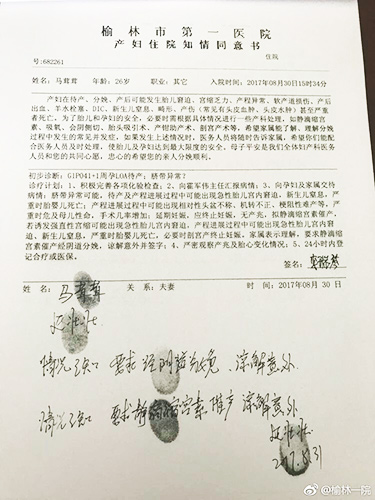Who is lying? Six puzzles to be solved in "maternal jumping off a building"
Cctv news(Reporter Wang Jiazhu) On the evening of September 5, with the "re-explanation" of the hospital and further interviews with the maternal family members by the media, the Yulin maternal jumping incident fell into a second round of public opinion disputes. The truth of this incident is far from coming. The reporter combed the information disclosed in the past few days and the hot discussion on the Internet, and found that there are many puzzles to be solved in this incident.
Puzzle 1: Is the evidence provided by the hospital convincing?

Before delivery, the parturient couple signed the Informed Consent of Maternity Hospitalization, and signed it and confirmed the willingness to give birth by fingerprint. (Source: Guan Wei of Yulin First Hospital)
On the internet, many netizens pointed out that the "notice of hospitalization" given by the hospital was a notice when the mother first entered the hospital, not the day of the incident, but a preliminary diagnosis. After careful examination, it will be found that the initial diagnosis and treatment plan of the hospital in this notice was originally "quasi-intravenous uterine contraction to induce labor", that is, natural delivery. The "situation is known, vaginal delivery is required, and the accident is forgiven" confirmed by the patient’s family members, so this notice cannot be used as evidence for the patient’s family members to refuse caesarean section.
Moreover, the "understanding accident" here only represents the recognition of the patient’s family members on the treatment methods under the known circumstances, and does not represent the attitude when the situation changes.
In addition, the hospital also produced a nursing record sheet, which recorded that the patient asked for cesarean section, the nurse "gave psychological comfort" and "explained it to his family once", and the family "expressed understanding" and "refused the operation". But the meaning is vague, and the authenticity of this nursing record sheet is in doubt.
Puzzle 2: Is the mother kneeling or squatting?

In the surveillance video, the mother fell to the ground (pictureSource: Guan Wei of Yulin First Hospital)
On September 6th, Yulin No.1 Hospital released three video screenshots, and two of them were accompanied by words explaining "The first time the parturient kneels down" and "The second time the parturient kneels down". The husband of the deceased did not recognize the contents of the hospital statement. He said: "It’s not kneeling, she can’t stand the pain, and I can’t help it if people go down."
Literally speaking, there is a great difference between kneeling and squatting. In the context of the hospital, kneeling obviously means that the mother kneels and asks her family members to agree to caesarean section, and the family members are suspected of forcing the mother to give birth naturally. Therefore, the difference between kneeling and squatting is completely different from the responsibility behind it.
At present, because there is no sound in the video released by the hospital, it is impossible to further judge the situation at that time, and it cannot be used to show that the family refused the request of caesarean section.
Puzzle 3: What happened in the 34 minutes before the mother jumped off the building?
According to the disclosure and media reports of Yulin No.1 Hospital, Ma spent the last two hours in the hospital like this: at 18: 05, she came out of the labor room for the first time and knelt down for the second time 10 minutes later, and then returned to the labor room; At 19: 19, he came out of the labor room for the second time and returned to the labor room again after 19: 26; Jumped to his death at 20: 00.
There is no internal content in the delivery room in the video released by the hospital, and it is not known whether there is video surveillance in the delivery room. The hospital also said that there were five parturients and second-line midwives in the waiting room at the time of the incident, but up to now, these parturients and midwives have not spoken to the outside world through the media or the hospital.
Puzzle 4: Both sides have proposed caesarean section. Who is lying?
In the two explanations from September 3 to September 6, Yulin No.1 Hospital repeatedly stated that "the doctor in charge, the midwife and the director of the department also proposed cesarean section to their families, which were all rejected by their families".
The hospital’s statement was denied by the maternal husband and other family members. The maternal husband said that when his wife was in unbearable pain, she also proposed to have a cesarean section, and she had called to find someone. The maternal husband’s cousin also said that the family members present also asked for caesarean section when the maternal pain was unbearable, but "the doctor still said that she could give birth immediately and could not do caesarean section, and then pulled people in."
If both parties say that they propose caesarean section when the maternal pain is unbearable, then one party must be lying.
Puzzle 5: Why didn’t the mother withdraw her authorization when the pain was unbearable?
He Bing, a law professor at China University of Political Science and Law, believes that there is no legal causal relationship between family members’ disagreement and not giving birth to a mother. At this time, my family has the right to sign and decide the operation, but I also have the right to decide! When family members’ opinions conflict with me, I shall prevail, and I have the final decision. "If the family doesn’t agree, the mother can revoke the Power of Attorney or sign it herself."
However, Ma, who was in unbearable pain, did not make this decision, but chose to go out of the delivery room and communicate with her husband when the pain was unbearable. The reason is unknown. Maybe she doesn’t even know that there are legal provisions that can protect her.
Puzzle 6: Why doesn’t the hospital deal with it urgently?
The Tort Liability Law of People’s Republic of China (PRC) clearly defines that if the opinions of patients or their close relatives cannot be obtained due to emergency situations such as saving dying patients, the corresponding medical measures can be implemented immediately with the approval of the person in charge of the medical institution or the authorized person in charge.
Moreover, on the "informed consent of patients" signed the day before, the family members have clearly written "understanding the accident", that is, understanding that the hospital will adopt various methods including "cesarean section".
However, in response, the hospital still gave the statement that "the maternity signed the Power of Attorney, and the hospital has no right to change the mode of production without the consent of the authorized person (Ma’s husband)", and the disposal method was doubtful.














 We have no tomorrow
We have no tomorrow
 Rashomon
Rashomon
 Night of heels
Night of heels

